“Cynicism masquerades as wisdom, but it is the farthest thing from it. Because cynics don’t learn anything. Because cynicism is a self-imposed blindness, a rejection of the world because we are afraid it will hurt us or disappoint us.”--Stephen Colbert Commencement Address, 2006
If discovery is the antidote to cynicism, I need to send thanks to Pacific Northwest National Laboratory, Fred Hutchinson Cancer Research Center, Washington State University and the University of Washington for opening my eyes to more than 40 of the latest early-stage innovations in cyber & data, materials sciences, life sciences and cleantech at SciTech Northwest 2018.
Amidst a week filled with pipe bombs and putrid hate speech, it’s heartening to know there are still incredibly talented people moving humanity forward. Here’s hoping they have the same impact for you, whether it be a promising tomorrow or a promising investment opportunity. Did I mention all of these science experiments are looking for licensing partners or investors?
While you can see the entire list of technologies at the SciTech Northwest 2018 website, here were some of my favorites:
- 3-D Printed Thermoplastic Composites–Despite calls for more STEM programs, school districts across America are chronically underfunded when it comes to laboratory equipment and mobile devices. To assist, PNNL scientists are using thermoplastics which can be 3-D printed into a Smartphone Microscope for 5¢ (yes, five cents). Now, smartphones and tablets can have their own portable and powerful microscope at a price every school district can afford.

5¢ Microscope For Tablets
- High Energy Cathodes for Rechargeable Lithium-Sulfur Batteries–If you could double the driving range of an electric vehicle while cutting the volume of the battery in half, what kind of impact do you think it would have on EV sales? Thanks to Jun Liu and her colleagues at PNNL, we are closer than ever to achieving that feat. By embedding novel additives in thick sulfur electrodes, they were able to promote quick electrolyte infiltration, which in turn significantly improved battery energy output over the current standard EV lithium-ion battery.
- Solid Phase Processing Technologies--It’s no secret one of the keys to better car and truck fuel efficiency is reducing the weight of the vehicle. One of the obstacles to achieving it is welding (or extruding) together components that are made of varying thicknesses or materials. PNNL’s friction stir welding is a process which can achieve this outcome without melting the materials. The process is ten times faster than current friction stir welding techniques so manufacturers can meet high-volume assembly requirements. As a result, they were able to create a car door 62 percent lighter than the typical door on the market today made with current manufacturing methods.
Since I never got up early enough to go to physics and engineering classes in college, I only get to live vicariously through the inventors, but if you’d like to be a more active participant, I urge you to contact one of these labs or research centers. I’m including the email addresses of their partnership and commercialization contacts, so you don’t have any excuses.
Pacific Northwest National Laboratory
Fred Hutchinson Cancer Research Center

